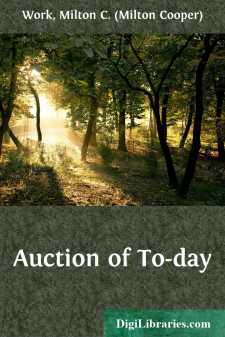Categories
- Antiques & Collectibles 13
- Architecture 36
- Art 48
- Bibles 22
- Biography & Autobiography 813
- Body, Mind & Spirit 142
- Business & Economics 28
- Children's Books 17
- Children's Fiction 14
- Computers 4
- Cooking 94
- Crafts & Hobbies 4
- Drama 346
- Education 46
- Family & Relationships 57
- Fiction 11829
- Games 19
- Gardening 17
- Health & Fitness 34
- History 1377
- House & Home 1
- Humor 147
- Juvenile Fiction 1873
- Juvenile Nonfiction 202
- Language Arts & Disciplines 88
- Law 16
- Literary Collections 686
- Literary Criticism 179
- Mathematics 13
- Medical 41
- Music 40
- Nature 179
- Non-Classifiable 1768
- Performing Arts 7
- Periodicals 1453
- Philosophy 64
- Photography 2
- Poetry 896
- Political Science 203
- Psychology 42
- Reference 154
- Religion 513
- Science 126
- Self-Help 84
- Social Science 81
- Sports & Recreation 34
- Study Aids 3
- Technology & Engineering 59
- Transportation 23
- Travel 463
- True Crime 29
Auction of To-day
Categories:
Description:
Excerpt
INTRODUCTION
With so many excellent textbooks now in circulation, it seems almost audacious to add another treatise to current card literature. It happens, however, that the game of Auction, or Auction Bridge, as it is generally called ("Auction Whist" is perhaps a more appropriate title), has been so completely and so suddenly revolutionized that books written upon the subject a few months ago do not treat of Auction of to-day, but of a game abandoned in the march of progress. Only a small portion of the change has been due to the development of the game, the alteration that has taken place in the count having been the main factor in the transformation. Just as a nation, in the course of a century, changes its habits, customs, and ideas, so Auction in a few months has developed surprising innovations, and evolved theories that only yesterday would have seemed to belong to the heretic or the fanatic. The expert bidder of last Christmas would find himself a veritable Rip Van Winkle, should he awake in the midst of a game of to-day.
The present tourist along the newly macadamized Auction highway has no modern signpost to guide him, no milestone to mark his progress. The old ones, while most excellent when erected, now lead to abandoned and impassable roads, and contain information that of necessity confuses and misleads.
Beyond doubt, the present game, like other modern improvements, has come to stay, and with that belief the following pages are offered as an aid to the thorough understanding of the new order of things.
Until the latter part of 1911, practically all players used the same count in Auction that had for years obtained in Bridge; namely, No-trump, 12; Hearts, 8; Diamonds, 6; Clubs, 4; and Spades, 2. The change was first suggested by the author, and it, therefore, seems only appropriate that he, having had the good fortune to conceive a system which has been endorsed by general adoption, should have the privilege of giving to the Auction-loving public his views upon the most advantageous methods of playing the game under the new conditions, and thus possibly help to allay the confusion created by the introduction of an innovation so drastic.
In this connection, it may be interesting to recall how this new count, which is now so universally used that it should be called, not the "new" count, but "the" count, came to be suggested, and why it met with popular favor.
When Auction first took the place of Bridge as the paramount game in the club and social life of the scientific card-player of the United States (just as Bridge had previously superseded Whist), it was but natural that the Bridge count should be continued in Auction.
Admitting that these values were the best possible for Bridge (and of that there is considerable doubt in the mind of the player of to-day), it, nevertheless, did not mean that for the new and very different game of Auction they would of necessity be the most suitable. It was soon found that the No-trump was so much more powerful than any other bid that competition was almost eliminated....


